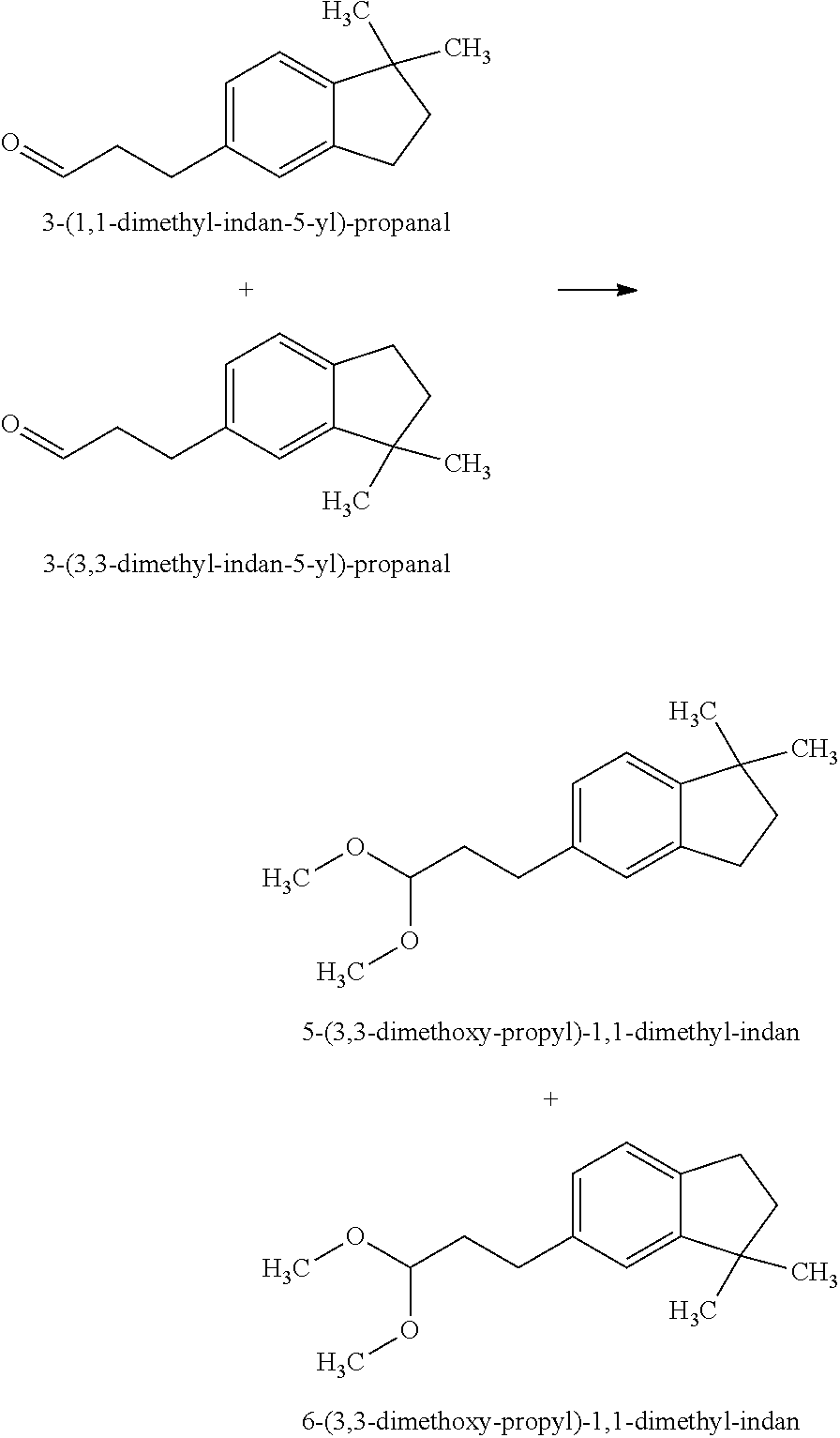Novel octahydroindenyl propanal compounds
a technology of octahydroindenyl propanal and compound, applied in the field of new chemical entities, can solve the problems of difficult identification of desirable fragrance chemicals, difficult for those with skill in the art to predict the effectiveness of a given structure, etc., and achieve the effect of enhancing, improving or modifying the fragrance of perfumes, colognes, toilet water
- Summary
- Abstract
- Description
- Claims
- Application Information
AI Technical Summary
Benefits of technology
Problems solved by technology
Method used
Image
Examples
example i
[0065]
Preparation of 5-(3,3-Dimethoxy-propyl)-1,1-dimethyl-indan and 6-(3,3-Dimethoxy-propyl)-1,1-dimethyl-indan
[0066]The mixture of 3-(1,1-dimethyl-indan-5-yl)-propanal and 3-(3,3-dimethyl-indan-5-yl)-propanal in a weight ratio of 40:60 (See, U.S. Pat. No. 5,552,379) (150 g, 0.74 mol) was dissolved in trimethyl orthoformate (HC(OCH3)3) (250 g) and methanol (50 g) and cooled to −10° C. Hydrochloric acid (HCl) (12 M, 1 mL) was added and the reaction rapidly exothermed to 40° C. Sodium acetate (CH3COONa) (20 g) was added. The resulting reaction mixture was distilled to provide the mixture of 5-(3,3-dimethoxy-propyl)-1,1-dimethyl-indan and 6-(3,3-dimethoxy-propyl)-1,1-dimethyl-indan in a weight ratio of 40:60 (170 g).
[0067]The mixture of 5-(3,3-dimethoxy-propyl)-1,1-dimethyl-indan and 6-(3,3-dimethoxy-propyl)-1,1-dimethyl-indan was described as having chemical, kerosene-like, muguet and spicy notes.
[0068]The mixture of 5-(3,3-dimethoxy-propyl)-1,1-dimethyl-indan and 6-(3,3-dimethoxy-pr...
example ii
[0070]
Preparation of 3-(1,1-Dimethyl-octahydro-inden-5-yl)-propanal (Formula Ia) and 3-(3,3-Dimethyl-octahydro-inden-5-yl)-propanal (Formula Ib)
[0071]The mixture of 5-(3,3-dimethoxy-propyl)-1,1-dimethyl-indan and 6-(3,3-dimethoxy-propyl)-1,1-dimethyl-indan (obtained as above in EXAMPLE I) (108 g, 435 mmol) in isopropanol (CH3CHOHCH3) (200 mL) was hydrogenated over ruthenium (IV) oxide (RuO2) at 60° C. under 400 psi hydrogen (H2) for 8 hours. The reaction was cooled and vented to atmospheric pressure. The resulting mixture was filtered through Celite® and evaporated to dryness. The crude was dissolved in methyl ethyl ketone (MEK) (CH3C(O)CH2CH3) (200 mL). To the crude solution was added water (50 mL) and HCl (12 M, 1 mL) and the resulting mixture was heated to reflux for 1 hour. The reaction was then cooled and toluene (20 mL) was added. The organic layer was separated and evaporated to dryness. Further distillation provided the mixture of 3-(1,1-dimethyl-octahydro-inden-5-yl)-propan...
example iii
[0075]
Preparation of 1-(1,1-Dimethyl-indan-5-yl)-ethanone and 1-(3,3-Dimethyl-indan-5-yl)-ethanone
[0076]Aluminum chloride (AlCl3) (408 g, 3.1 mol) was dissolved in dichloromethane (CH2Cl2) (1 L) and cooled to 0° C. Acetyl chloride (CH3COCl) (240 g, 3.1 mol) was fed in over 30 minutes. While the temperature was maintained at 0° C., 1,1-dimethyl-indan (448 g, 3.1 mol) was added and the mixture was stirred for 2 hours. The resulting mixture was poured into ice (5 Kg). The organic layer was then separated and distilled to provide a clear oil comprising the mixture of 1-(1,1-dimethyl-indan-5-yl)-ethanone and 1-(3,3-dimethyl-indan-5-yl)-ethanone in a weight ratio of 40:60 (420 g).
[0077]The mixture of 1-(1,1-dimethyl-indan-5-yl)-ethanone and 1-(3,3-dimethyl-indan-5-yl)-ethanone was described as having chemical, kerosene, gassy and spicy notes.
1-(1,1-Dimethyl-indan-5-yl)-ethanone
[0078]1H NMR (CDCl3, 500 MHz): 7.77-7.81 (m, 1H), 7.73-7.76 (m, 1H), 7.24 (d, J=8.5 Hz, 1H), 2.92 (t, J=7.3 Hz, 2...
PUM
| Property | Measurement | Unit |
|---|---|---|
| weight percent | aaaaa | aaaaa |
| weight percent | aaaaa | aaaaa |
| weight percent | aaaaa | aaaaa |
Abstract
Description
Claims
Application Information
 Login to View More
Login to View More - R&D
- Intellectual Property
- Life Sciences
- Materials
- Tech Scout
- Unparalleled Data Quality
- Higher Quality Content
- 60% Fewer Hallucinations
Browse by: Latest US Patents, China's latest patents, Technical Efficacy Thesaurus, Application Domain, Technology Topic, Popular Technical Reports.
© 2025 PatSnap. All rights reserved.Legal|Privacy policy|Modern Slavery Act Transparency Statement|Sitemap|About US| Contact US: help@patsnap.com



